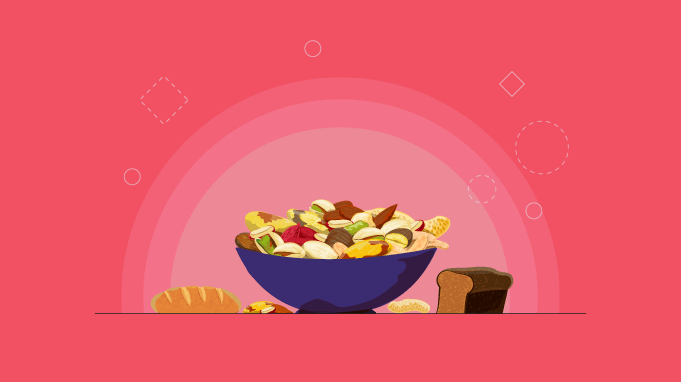For people on high-protein diets, finding variety in food can be difficult, and this leads to low satisfaction with meals and a lack of enthusiasm for food. Luckily for your diet, flavorful, unique, and high-protein snacks are more abundant than you may realize. This list offers just a few tried-and-true favorites that might just become staples in your pantry, and if you’re not careful, your friends might start eating them, too.
8 High-Protein Snacks to Try This Season
1. Roasted Chickpeas
Chickpeas are the seed of Cicer arietinum, a member of the legume family and one of the oldest cultivated plants on the planet, having been eaten by humans for nearly 10,000 years. They’re a favorite ingredient in cuisines all over the world, and they make for a satisfying, nutritious snack. You’ve probably had them in the form of hummus, which is made by soaking and blending chickpeas with salt, tahini, and lemon juice for an unforgettable spread.
But did you know you can roast them for a delicious, high-protein snack that keeps well and is easy to eat on the go? Crunchy roasted chickpeas are often available in the bulk section at the grocery store, or you can make your own with a few simple seasonings and an oven.
2. White Bean Popcorn
If you’re the type of person who just can’t get enough of legumes, then you’ll also want to try this underrated, highly nutritious snack. Much like regular corn, you can pop any type of white bean—cannellini, white kidney, and navy beans all work—by roasting it in the oven. Just take some pre-soaked beans, dry them out, and stick them on a baking sheet. Cook them at 425° for about 30 minutes, and eventually, you’ll hear them start to pop. This crispy snack is high in protein and flavor.
3. Magic Spoon Cereal
If you have childhood memories of snacking on handfuls of sweet cereal after school or on Saturday mornings, Magic Spoon cereal was made just for you. This tasty, grain-free cereal is perfect for all times of day, and it packs a whopping 13 grams of protein into a single serving, all while having 0g of sugar and only 4 – 5 net carbs. It comes in a variety of flavors, from Blueberry Muffin to Cookies & Cream, and you can even buy it in variety packs. This cereal for grown-ups has everything you could want in a healthy, scrumptious breakfast or snack.
4. Nutritional Yeast
While many people still haven’t heard of nutritional yeast, it’s been making the rounds in vegan circles and steadily becoming more popular. With its notably deep, savory flavor, this product is often used as a substitute for cheese in pasta dishes, and it also makes an excellent addition to a bowl of popcorn. You can add nutritional yeast to just about anything savory, and it boasts an impressive amount of protein—nearly 11 grams per 20-gram serving! Try it sprinkled over eggs for breakfast, mixed with water as a spreadable paste, or incorporated into sauces.
5. Greek Yogurt
While many regular yogurts sold in stores are high in sugar and low in protein, Greek yogurt is made through a different process and has a completely different taste, texture, and nutrient profile. Just a cup of Greek yogurt can have up to 20 grams of protein. It comes in a variety of flavors at the store, but plain Greek yogurt is a versatile and welcome ingredient in many dishes.
One popular choice is to mix it with a combination of granola, fruit, peanut butter, and chia or hemp seeds to make a parfait. These make for delicious snacks absolutely brimming with nutrients. You can also use it as a substitute for sour cream, in baked goods and sauces, and as a base for shakes and smoothies. In addition to protein, it’s also a good source of calcium.
6. Peanut Butter
No list of high-protein foods is complete without this longtime fan favorite. Peanut butter is a preferred snack for hikers, backpackers, athletes, and so many more active individuals. It’s affordable, even when it’s organic, and it offers an important array of fats, proteins, and carbs for a filling, nutritious snack. Peanut butter is known to encourage a feeling of fullness, and it can also be included in no-bake recipes to help you maximize your protein efficiency.
It can also be eaten like a dip with fruits and vegetables, such as apples and celery. However, peanuts are one of the most common allergens in the US, so this option won’t be suitable for everyone. It’s also not ideal for someone trying to aggressively cut carbs.
7. Lentil Soup
Lentils are among the most popular plant-based protein sources because, in addition to being delicious and versatile, they also offer important nutrients that can be hard to find elsewhere in your diet, like iron and manganese. They fit with many different herbs and spices and are very affordable.
Lentils can be cooked into many different varieties of soup, from thin and brothy to thick and hearty. Lentil soup reheats well, and the flavor continues to develop after cooking. Small portions of thick soups can also be combined with other foods, like eggs and bread, for more complete meals.
8. Kefir
If you’re looking for another source of dairy protein other than cheese and Greek yogurt, kefir might just be what you’ve been hoping for. This sweet, nutritious drink is similar to yogurt, but it’s been further fermented. This means it’s packed full of living probiotics and has a relatively low sugar content, since the Lactobacillus bacteria used in fermentation eat the sugar during the process, leaving behind a unique and wonderful flavor.
Kefir comes in many different forms, though blueberry, strawberry, and plain are the most common varieties. It makes a great base for a smoothie or pudding. Mix kefir with chia seeds to make a pudding unlike anything you’ve ever tried before. And if you’re brave, you can even cultivate your own kefir at home!
Whether you have all afternoon to prepare something or need a quick bite, there are plenty of ways to get more protein and flavor. Say goodbye to empty carbs and calories and hello to nutrient-rich snacks.


